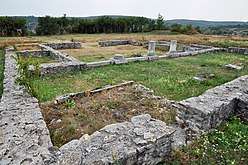Castra of Buciumi
The castra of Buciumi was a fort in the Roman province of Dacia in the 2nd and 3rd centuries AD.[1][3] Remains of the surrounding vicus were also unearthed.[3] The castra's ruins are located in Buciumi, Romania.[1][3]
| Castra of Buciumi | |
|---|---|
 Principia | |
 Location within Romania | |
| Founded | 2nd century AD[1] |
| Abandoned | 3rd century AD[1] |
| Place in the Roman world | |
| Province | Dacia |
| Administrative unit | Dacia Porolissensis |
| Administrative unit | Dacia Superior |
| Limes | Porolissensis |
| Directly connected to | |
| Structure | |
| — Stone structure — | |
| Size and area | 134 m × 167 m (2.2 [2] ha) |
| — Wood and earth structure — | |
| Size and area | 125 m × 160 m (2.0 [2] ha) |
| Stationed military units | |
| — Cohorts — | |
| Location | |
| Coordinates | 47.048292°N 23.044678°E |
| Altitude | 373 m |
| Place name | Grădiște |
| Town | Buciumi |
| County | Sălaj |
| Country | |
| Reference | |
| RO-LMI | SJ-I-s-A-04862[3] |
| RO-RAN | 140388.03[1] |
| Site notes | |
| Recognition | |
| Condition | Ruined |
| Exhibitions | County Museum of History and Art, Zalău |
Gallery
- Via Praetoria
- Porta Praetoria
- Via Principalis
- Porta Principalis Dextra
- Porta Principalis Sinistra
- South round tower
- Columns of Principia
- Principia
gollark: Just "".
gollark: PotatOS doesn't have enchat built in.
gollark: Cross server capability.
gollark: Enchat does run over skynet, yes.
gollark: Skynet + Skyrelay + a modem snooper literally does that already.
See also
- List of castra
Notes
- "140388.03". National Archaeological Record of Romania (RAN). ran.cimec.ro. 7 May 2009. Archived from the original on 16 April 2013. Retrieved 4 January 2013.
- "Buciumi". Archived from the original on 2012-03-16. Retrieved 2011-08-01.
- "Lista Monumentelor Istorice 2010 ("2010 List of Historic Monuments")" (PDF). Monitorul Oficial al României, Partea I, Nr. 670 ("Romania's Official Journal, Part I, Nr. 670"), page 2082. Ministerul Culturii şi Patrimoniului Naţional. 1 October 2010. Archived from the original (PDF) on 10 June 2012. Retrieved 4 January 2013.
External links

- Roman castra from Romania - Google Maps / Earth
This article is issued from Wikipedia. The text is licensed under Creative Commons - Attribution - Sharealike. Additional terms may apply for the media files.